Fabrication of a TiC-Ti Matrix Composite Coating Using Ultrasonic Vibration-Assisted Laser Directed Energy Deposition: The Effects of Ultrasonic Vibration and TiC Content
Abstract
1. Introduction
2. Materials and Methods
2.1. Powder Materials and Treatment
2.2. Experimental Setup
2.3. Measurement Procedures
3. Results and Discussion
3.1. Phase Compositions
3.2. Microstructure
3.3. Bonding Quality
3.4. Fabrication Defects
3.5. Mechanical Properties
3.5.1. Microhardness
3.5.2. Wear Resistance
4. Conclusions
Author Contributions
Funding
Institutional Review Board Statement
Informed Consent Statement
Data Availability Statement
Conflicts of Interest
References
- Peters, M.; Kumpfert, J.; Ward, C.H.; Leyens, C. Titanium Alloys for Aerospace Applications. Adv. Eng. Mater. 2003, 5, 419–427. [Google Scholar] [CrossRef]
- Hartman, A.D.; Gerdemann, S.J.; Hansen, J.S. Producing lower-cost titanium for automotive applications. JOM 1998, 50, 16–19. [Google Scholar] [CrossRef]
- Attar, H.; Bönisch, M.; Calin, M.; Zhang, L.C.; Scudino, S.; Eckert, J. Selective laser melting of in situ titanium-titanium boride composites: Processing, microstructure and mechanical properties. Acta Mater. 2014, 76, 13–22. [Google Scholar] [CrossRef]
- Guo, C.; Zhou, J.; Chen, J.; Zhao, J.; Yu, Y.; Zhou, H. Improvement of the oxidation and wear resistance of pure Ti by laser cladding at elevated temperature. Surf. Coat. Technol. 2010, 205, 2142–2151. [Google Scholar] [CrossRef]
- Dhanda, M.; Haldar, B.; Saha, P. Development and characterization of hard and wear resistant MMC coating on Ti-6Al-4V substrate by laser cladding. Procedia Mater. Sci. 2014, 6, 1226–1232. [Google Scholar] [CrossRef]
- Cui, Z.; Yang, H.; Wang, W.; Wu, H.; Xu, B. Laser cladding Al-Si/Al2O3-TiO2 composite coatings on AZ31B magnesium alloy. J. Wuhan Univ. Technol. Mater. Sci. Ed. 2012, 27, 1042–1047. [Google Scholar] [CrossRef]
- Song, S.X.; Ai, X.; Zhao, J.; Huang, C.Z. Al2O3/Ti(C0.3N0.7) cutting tool material. Mater. Sci. Eng. A 2003, 356, 43–47. [Google Scholar] [CrossRef]
- Selamat, M.; Watson, L.; Baker, T. XRD and XPS studies on surface MMC layer of SiC reinforced Ti-6Al-4V alloy. J. Mater. Process. Technol. 2003, 142, 725–737. [Google Scholar] [CrossRef]
- Yoon, C.S.; Kang, S.; Kim, D.Y. Dissolution and reprecipitation behavior of TiC-TiN-Ni cermets during liquid-phase sintering. Korean J. Ceram. 1997, 3, 124–128. [Google Scholar]
- Fan, Z.; Miodownik, A.; Chandrasekaran, L.; Ward-Close, M. The Young’s moduli of in situ Ti/TiB composites obtained by rapid solidification processing. J. Mater. Sci. 1994, 29, 1127–1134. [Google Scholar] [CrossRef]
- Yuan, P.; Gu, D. Molten pool behaviour and its physical mechanism during selective laser melting of TiC/AlSi10Mg nanocomposites: Simulation and experiments. J. Phys. D Appl. Phys. 2015, 48, 035303. [Google Scholar] [CrossRef]
- Liu, W.; Dupont, J.N. Fabrication of functionally graded TiC/Ti composites by laser engineered net shaping. Scr. Mater. 2003, 48, 1337–1342. [Google Scholar] [CrossRef]
- Rambo, C.R.; Travitzky, N.; Zimmermann, K.; Greil, P. Synthesis of TiC/Ti–Cu composites by pressureless reactive infiltration of TiCu alloy into carbon preforms fabricated by 3D-printing. Mater. Lett. 2005, 59, 1028–1031. [Google Scholar] [CrossRef]
- Man, H.C.; Zhang, S.; Cheng, F.; Yue, T. Microstructure and formation mechanism of in situ synthesized TiC/Ti surface MMC on Ti-6Al-4V by laser cladding. Scr. Mater. 2001, 44, 2801. [Google Scholar] [CrossRef]
- Gu, D.; Meng, G.; Li, C.; Meiners, W.; Poprawe, R. Selective laser melting of TiC/Ti bulk nanocomposites: Influence of nanoscale reinforcement. Scr. Mater. 2012, 67, 185–188. [Google Scholar] [CrossRef]
- Joseph, J. Direct laser fabrication of compositionally complex materials: Challenges and prospects. Addit. Manuf. Appl. Met. Compos. 2020, 147–163. [Google Scholar] [CrossRef]
- Hu, Y.; Cong, W. A review on laser deposition-additive manufacturing of ceramics and ceramic reinforced metal matrix composites. Ceram. Int. 2018, 44, 20599–20612. [Google Scholar] [CrossRef]
- Farshidianfar, M.H.; Khajepour, A.; Gerlich, A.P. Effect of real-time cooling rate on microstructure in laser additive manufacturing. J. Mater. Process. Technol. 2016, 231, 468–478. [Google Scholar] [CrossRef]
- Pei, Y.; Zuo, T. Gradient microstructure in laser clad TiC-reinforced Ni-alloy composite coating. Mater. Sci. Eng. A 1998, 241, 259–263. [Google Scholar] [CrossRef]
- Yang, S.; Liu, W.; Zhong, M.; Wang, Z. TiC reinforced composite coating produced by powder feeding laser cladding. Mater. Lett. 2004, 58, 2958–2962. [Google Scholar] [CrossRef]
- Kathuria, Y. Nd-YAG laser cladding of Cr3C2 and TiC cermets. Surf. Coat. Technol. 2001, 140, 195–199. [Google Scholar] [CrossRef]
- Wu, W. Dissolution precipitation mechanism of TiC/Ti composite layer produced by laser cladding. Mater. Sci. Technol. 2010, 26, 367–370. [Google Scholar] [CrossRef]
- Ding, H.; Liu, X.; Yu, L.; Zhao, G. The influence of forming processes on the distribution and morphologies of TiC in Al-Ti-C master alloys. Scr. Mater. 2007, 57, 575–578. [Google Scholar] [CrossRef]
- Wu, X. In situ formation by laser cladding of a TiC composite coating with a gradient distribution. Surf. Coat. Technol. 1999, 115, 111–115. [Google Scholar] [CrossRef]
- Cong, W.; Ning, F. A fundamental investigation on ultrasonic vibration-assisted laser engineered net shaping of stainless steel. Int. J. Mach. Tools Manuf. 2017, 121, 61–69. [Google Scholar] [CrossRef]
- Wang, H.; Hu, Y.; Ning, F.; Cong, W. Ultrasonic vibration-assisted laser engineered net shaping of Inconel 718 parts: Effects of ultrasonic frequency on microstructural and mechanical properties. J. Mater. Process. Technol. 2020, 276, 468–478. [Google Scholar] [CrossRef]
- Li, M.; Zhang, Q.; Han, B.; Song, L.; Cui, G.; Yang, J.; Li, J. Microstructure and property of Ni/WC/La2O3 coatings by ultrasonic vibration-assisted laser cladding treatment. Opt. Lasers Eng. 2020, 125, 105848. [Google Scholar] [CrossRef]
- Ning, F.; Hu, Y.; Cong, W. Microstructure and mechanical property of TiB reinforced Ti matrix composites fabricated by ultrasonic vibration-assisted laser engineered net shaping. Rapid Prototyp. J. 2019, 25, 581–591. [Google Scholar] [CrossRef]
- Noltingk, B.E.; Neppiras, E.A. Cavitation produced by ultrasonics. Proc. Phys. Soc. Sect. B 1950, 63, 674. [Google Scholar] [CrossRef]
- Schneider, C.A.; Rasband, W.S.; Eliceiri, K.W. NIH Image to ImageJ: 25 years of image analysis. Nat. Methods 2012, 9, 671–675. [Google Scholar] [CrossRef]
- Kacher, J.; Landon, C.; Adams, B.L.; Fullwood, D. Bragg’s Law diffraction simulations for electron backscatter diffraction analysis. Ultramicroscopy 2009, 109, 1148–1156. [Google Scholar] [CrossRef]
- Ya, B.; Zhou, B.; Yang, H.; Huang, B.; Jia, F.; Zhang, X. Microstructure and mechanical properties of in situ casting TiC/Ti6Al4V composites through adding multi-walled carbon nanotubes. J. Alloys Compd. 2015, 637, 456–460. [Google Scholar] [CrossRef]
- Zhang, X.; Song, F.; Wei, Z.; Yang, W.; Dai, Z. Microstructural and mechanical characterization of in-situ TiC/Ti titanium matrix composites fabricated by graphene/Ti sintering reaction. Mater. Sci. Eng. A 2017, 705, 153–159. [Google Scholar] [CrossRef]
- Komarov, S.V.; Kuwabara, M.; Abramov, O.V. High power ultrasonics in pyrometallurgy: Current status and recent development. ISIJ Int. 2005, 45, 1765–1782. [Google Scholar] [CrossRef]
- Chrysanthou, A.; Chen, Y.; Vijayan, A.; O’sullivan, J. Combustion synthesis and subsequent sintering of titanium-matrix composites. J. Mater. Sci. 2003, 38, 2073–2077. [Google Scholar] [CrossRef]
- Ranganath, S.; Subrahmanyam, J. On the in situ formation of tic and ti2c reinforcements in combustion-assisted synthesis of titanium matrix composites. Met. Mater. Trans. A 1996, 27, 237–240. [Google Scholar] [CrossRef]
- Wanjara, P.; Drew, R.; Root, J.; Yue, S. Evidence for stable stoichiometric Ti2C at the interface in TiC particulate reinforced Ti alloy composites. Acta Mater. 2000, 48, 1443–1450. [Google Scholar] [CrossRef]
- Yuan, P.; Gu, D.; Dai, D. Particulate migration behavior and its mechanism during selective laser melting of TiC reinforced Al matrix nanocomposites. Mater. Des. 2015, 82, 46–55. [Google Scholar] [CrossRef]
- Li, Y.; Hu, Y.; Cong, W.; Zhi, L.; Guo, Z. Additive manufacturing of alumina using laser engineered net shaping: Effects of deposition variables. Ceram. Int. 2017, 43, 7768–7775. [Google Scholar] [CrossRef]
- Nazari, K.A.; Rashid, R.R.; Palanisamy, S.; Xia, K.; Dargusch, M.S. A novel Ti-Fe composite coating deposited using laser cladding of low cost recycled nano-crystalline titanium powder. Mater. Lett. 2018, 229, 301–304. [Google Scholar] [CrossRef]
- Wang, L.; Felicelli, S.; Gooroochurn, Y.; Wang, P.; Horstemeyer, M. Optimization of the LENS® process for steady molten pool size. Mater. Sci. Eng. A 2008, 474, 148–156. [Google Scholar] [CrossRef]
- Khosrofian, J.M.; Garetz, B. Measurement of a Gaussian laser beam diameter through the direct inversion of knife-edge data. Appl. Opt. 1983, 22, 3406–3410. [Google Scholar] [CrossRef]
- Lang, R.J. Ultrasonic atomization of liquids. J. Acoust. Soc. Am. 1962, 34, 6–8. [Google Scholar] [CrossRef]
- Fan, Z.; Zhao, Y.; Tan, Q.; Mo, N.; Zhang, M.-X.; Lu, M.; Huang, H. Nanostructured Al2O3-YAG-ZrO2 ternary eutectic components prepared by laser engineered net shaping. Acta Mater. 2019, 170, 24–37. [Google Scholar] [CrossRef]
- Zhang, B.; Li, Y.; Bai, Q. Defect formation mechanisms in selective laser melting: A review. Chin. J. Mech. Eng. 2017, 30, 515–527. [Google Scholar] [CrossRef]
- Rashid, R.R.; Palanisamy, S.; Attar, H.; Bermingham, M.; Dargusch, M.S. Metallurgical features of direct laser-deposited Ti6Al4V with trace boron. J. Manuf. Process. 2018, 35, 651–656. [Google Scholar] [CrossRef]
- Wang, R.; Gu, D.; Chen, C.; Dai, D.; Ma, C.; Zhang, H. Formation mechanisms of TiB2 tracks on Ti6Al4V alloy during selective laser melting of ceramic-metal multi-material. Powder Technol. 2020, 367, 597–607. [Google Scholar] [CrossRef]
- Shen, Y.-L.; Williams, J.; Piotrowski, G.; Chawla, N.; Guo, Y. Correlation between tensile and indentation behavior of particle-reinforced metal matrix composites: An experimental and numerical study. Acta Mater. 2001, 49, 3219–3229. [Google Scholar] [CrossRef]
- Liu, P.; Zhang, Y. A theoretical analysis of frictional and defect characteristics of graphene probed by a capped single-walled carbon nanotube. Carbon 2011, 49, 3687–3697. [Google Scholar] [CrossRef]
- Yang, J.; Gu, W.; Pan, L.; Song, K.; Chen, X.; Qiu, T. Friction and wear properties of in situ (TiB2+ TiC)/Ti3SiC2 composites. Wear 2011, 271, 2940–2946. [Google Scholar] [CrossRef]
- Li, J.; Yu, Z.; Wang, H. Wear behaviors of an (TiB+ TiC)/Ti composite coating fabricated on Ti6Al4V by laser cladding. Thin Solid Films 2011, 519, 4804–4808. [Google Scholar] [CrossRef]
- Deng, J.; Liu, L.; Yang, X.; Liu, J.; Sun, J.; Zhao, J. Self-lubrication of Al2O3/TiC/CaF2 ceramic composites in sliding wear tests and in machining processes. Mater. Des. 2007, 28, 757–764. [Google Scholar] [CrossRef]
- Feng, Y.; Zhang, J.; Wang, L.; Zhang, W.; Tian, Y.; Kong, X. Fabrication techniques and cutting performance of micro-textured self-lubricating ceramic cutting tools by in-situ forming of Al2O3-TiC. Int. J. Refract. Met. Hard Mater. 2017, 68, 121–129. [Google Scholar] [CrossRef]
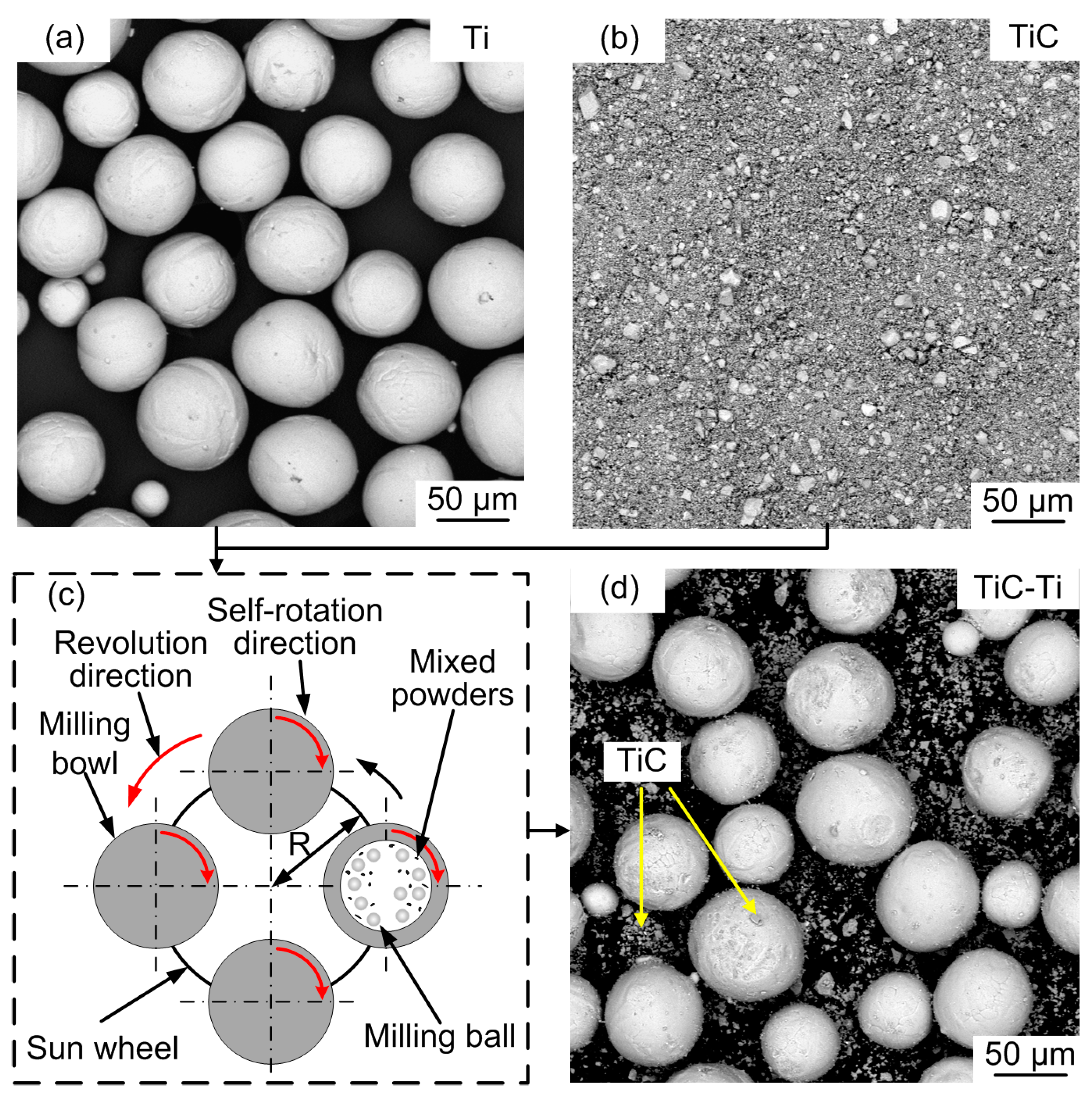

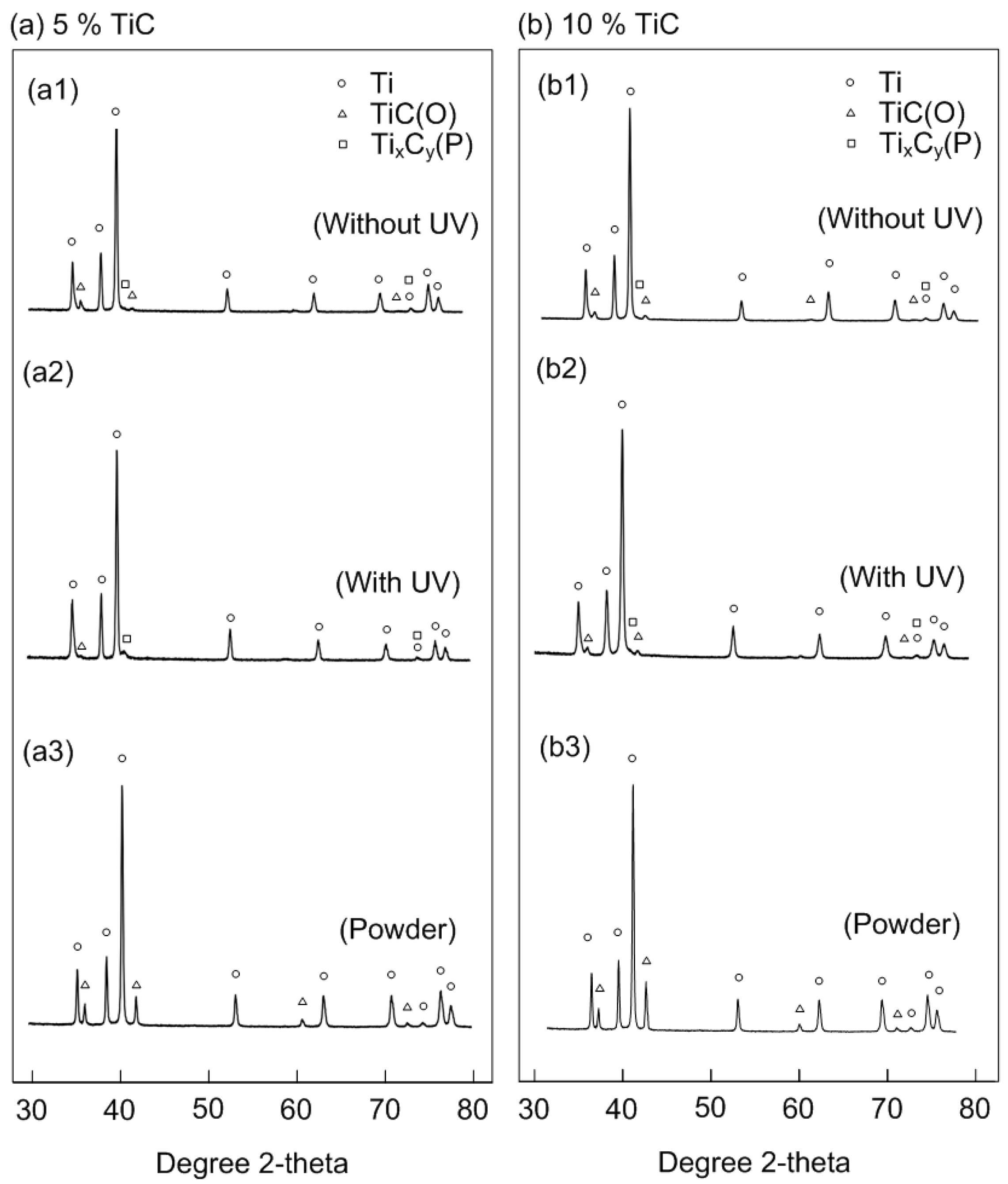
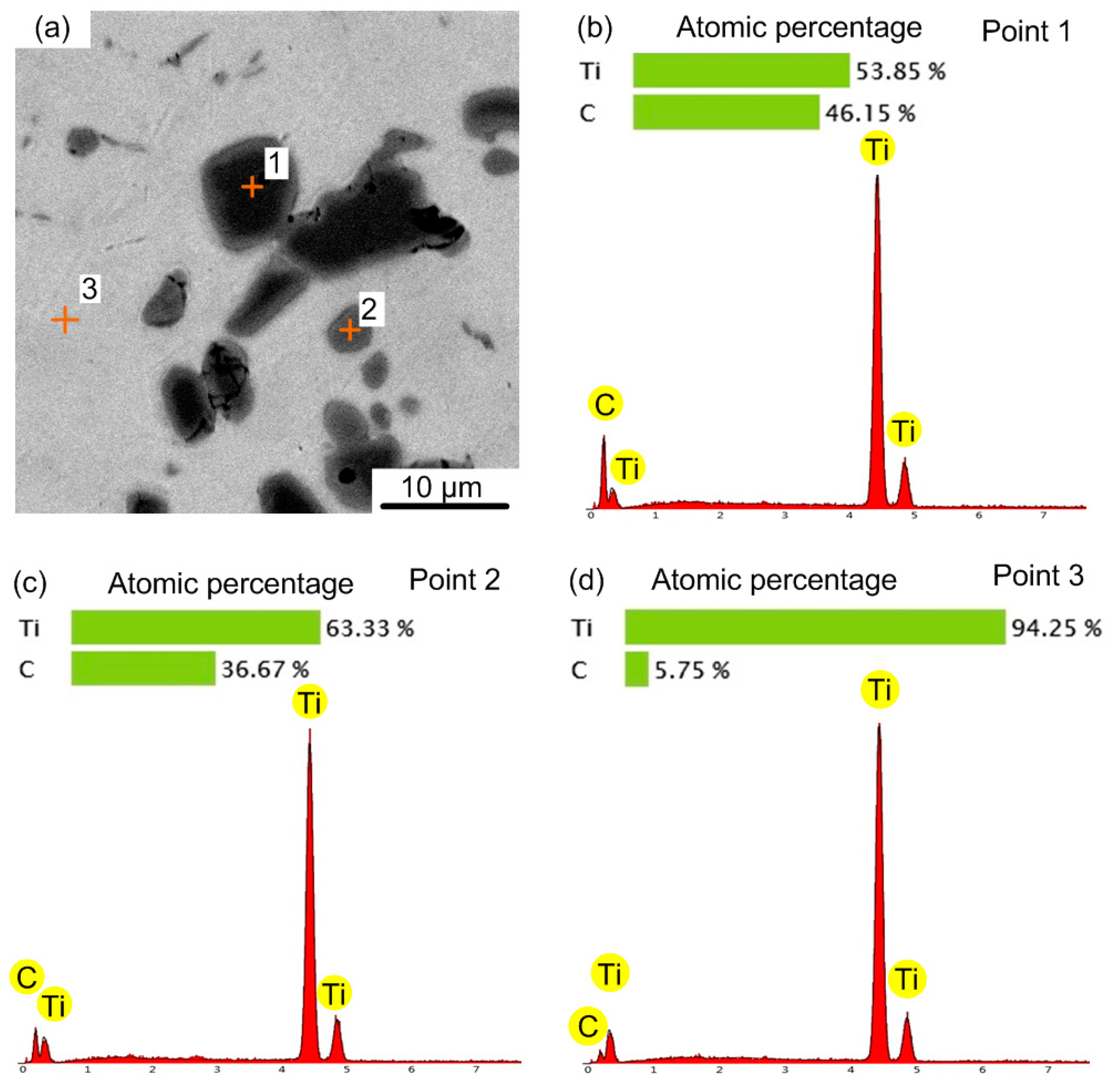
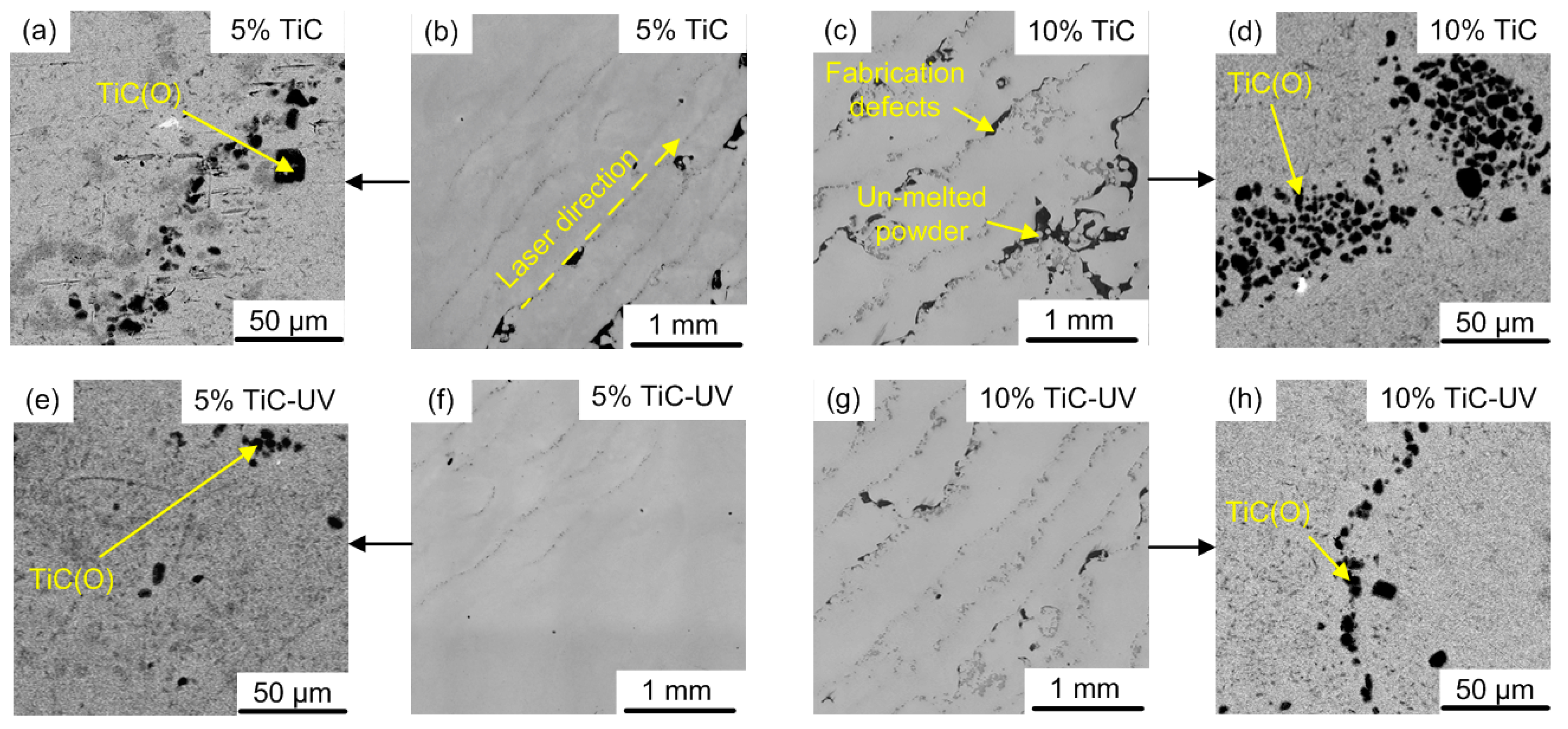
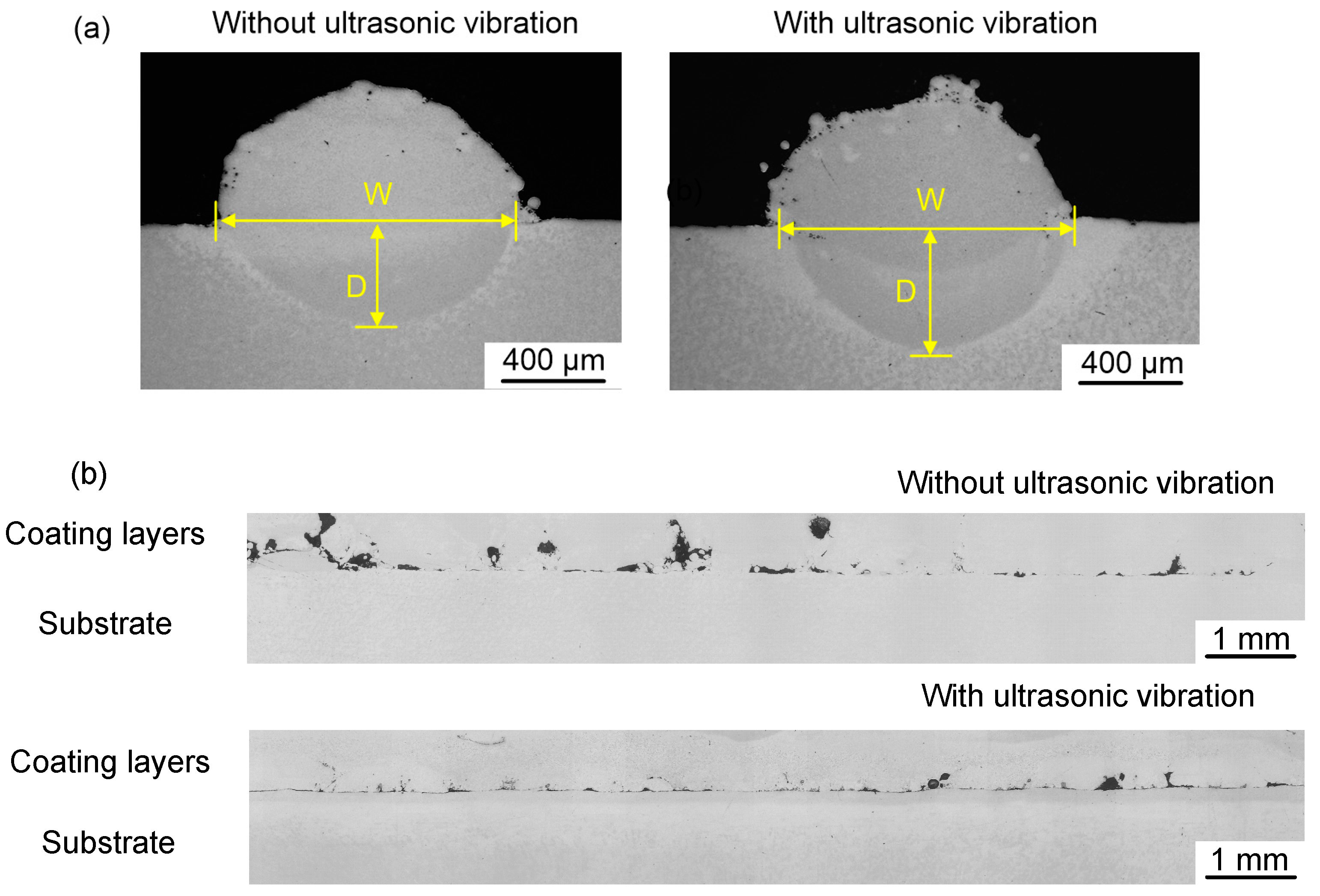
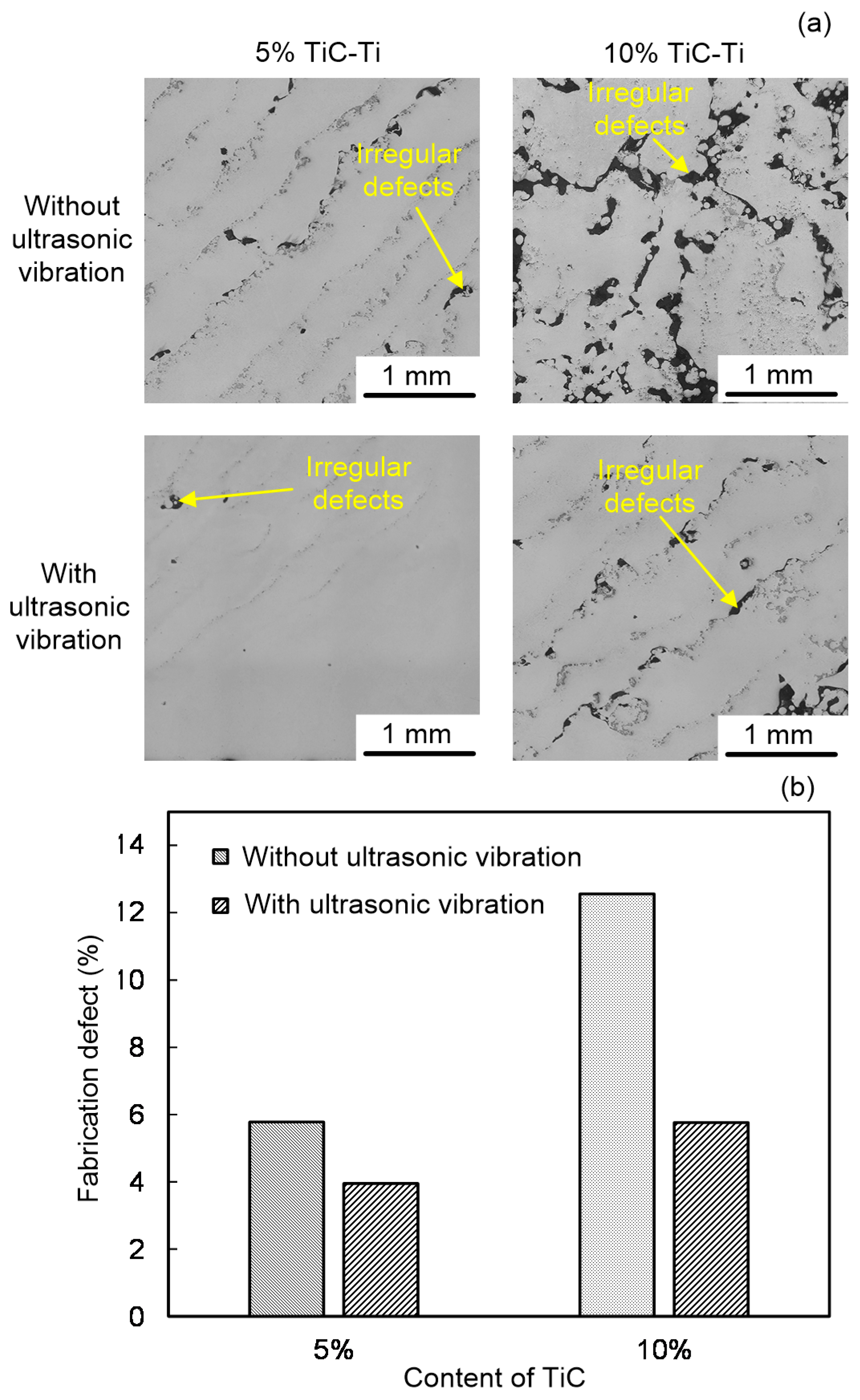
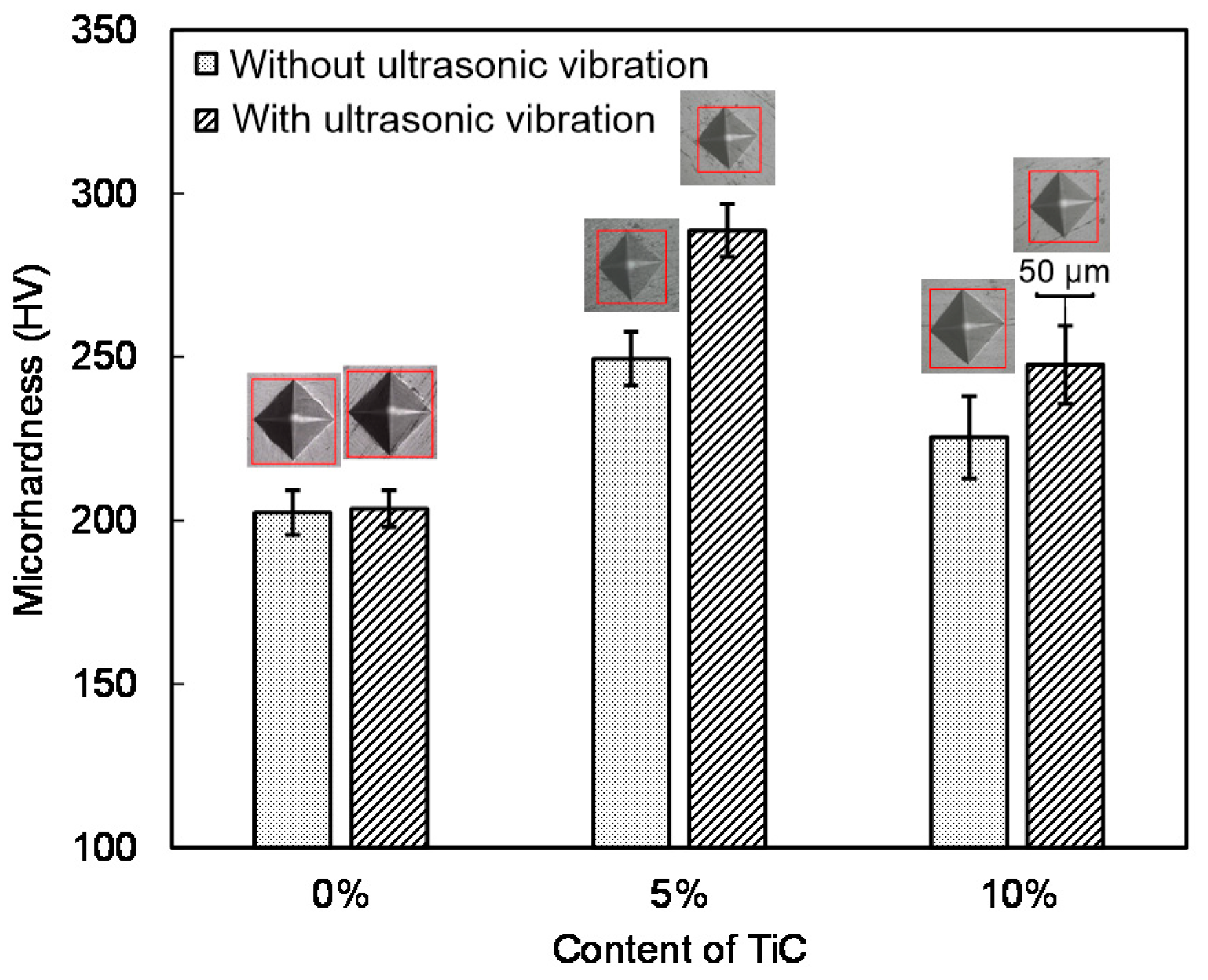

| Input Fabrication Variables | Value |
|---|---|
| Laser power (W) | 375 |
| Beam diameter of laser (µm) | 400 |
| Wavelength of laser (µm) | 1.07 |
| Deposit head scanning speed (mm/min) | 11 |
| Hatch distance (µm) | 380 |
| Layer thickness (µm) | 432 |
| Powder feeding rate (g/min) | 2.5 |
| Number of layers | 3 |
| Oxygen level (ppm) | <50 |
| Argon gas flow rate (L/min) | 6 |
| Scanning orientation (°) | 45, alternate 90 per layer |
| Conditions | TiC(O) (wt.%) | TixCy(P) (wt.%) | Ti (wt.%) |
|---|---|---|---|
| Feedstock powder | 5.24 | 0 | balance |
| TiC-TMC coatings without UV | 2.94 | 4.36 | balance |
| TiC-TMC coatings with UV | 0.72 | 6.98 | balance |
| Conditions | TiC(O) (wt.%) | TixCy(P) (wt.%) | Ti (wt.%) |
|---|---|---|---|
| Feedstock powder | 10.71 | 0 | balance |
| TiC-TMC coatings without UV | 6.89 | 5.87 | balance |
| TiC-TMC coatings with UV | 5.12 | 8.48 | balance |
| Conditions | Friction Coefficient |
|---|---|
| CP-Ti without UV | 0.322 |
| CP-Ti with UV | 0.324 |
| 5 wt.% TiC-TMC coatings without UV | 0.201 |
| 5 wt.% TiC-TMC coatings with UV | 0.129 |
| 10 wt.% TiC-TMC coatings without UV | 0.296 |
| 10 wt.% TiC-TMC coatings with UV | 0.268 |
Publisher’s Note: MDPI stays neutral with regard to jurisdictional claims in published maps and institutional affiliations. |
© 2021 by the authors. Licensee MDPI, Basel, Switzerland. This article is an open access article distributed under the terms and conditions of the Creative Commons Attribution (CC BY) license (https://creativecommons.org/licenses/by/4.0/).
Share and Cite
Li, Y.; Zhang, D.; Wang, H.; Cong, W. Fabrication of a TiC-Ti Matrix Composite Coating Using Ultrasonic Vibration-Assisted Laser Directed Energy Deposition: The Effects of Ultrasonic Vibration and TiC Content. Metals 2021, 11, 693. https://doi.org/10.3390/met11050693
Li Y, Zhang D, Wang H, Cong W. Fabrication of a TiC-Ti Matrix Composite Coating Using Ultrasonic Vibration-Assisted Laser Directed Energy Deposition: The Effects of Ultrasonic Vibration and TiC Content. Metals. 2021; 11(5):693. https://doi.org/10.3390/met11050693
Chicago/Turabian StyleLi, Yunze, Dongzhe Zhang, Hui Wang, and Weilong Cong. 2021. "Fabrication of a TiC-Ti Matrix Composite Coating Using Ultrasonic Vibration-Assisted Laser Directed Energy Deposition: The Effects of Ultrasonic Vibration and TiC Content" Metals 11, no. 5: 693. https://doi.org/10.3390/met11050693
APA StyleLi, Y., Zhang, D., Wang, H., & Cong, W. (2021). Fabrication of a TiC-Ti Matrix Composite Coating Using Ultrasonic Vibration-Assisted Laser Directed Energy Deposition: The Effects of Ultrasonic Vibration and TiC Content. Metals, 11(5), 693. https://doi.org/10.3390/met11050693






